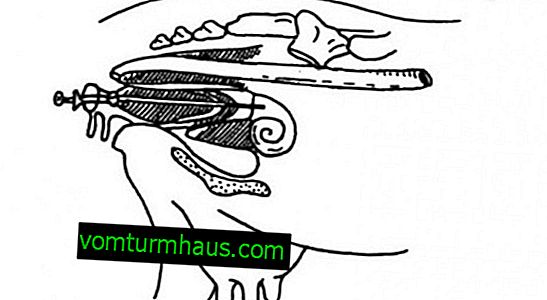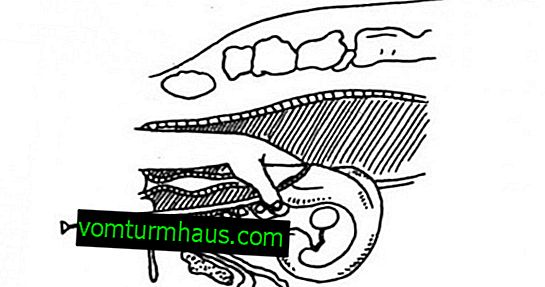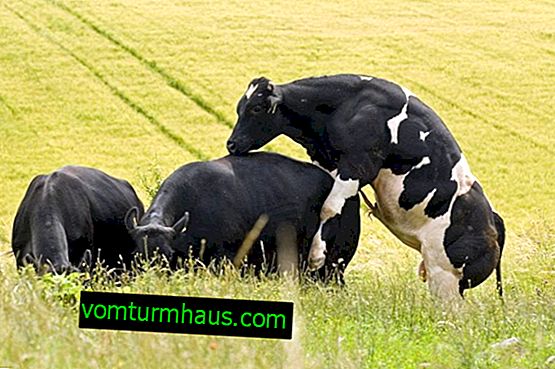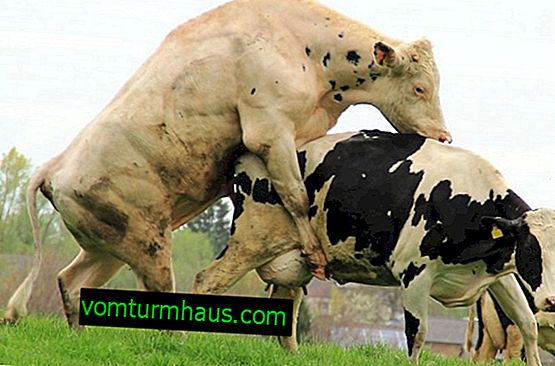Ways of inseminating cows: the right technique and preparation
Insemination of cows is an integral part of their maintenance for almost any farmer, because further regular milkings depend on this process. Currently, several basic methods of fertilization of cattle are used, but more often than others artificial insemination is used. What you need to know about the features of this type, how to recognize a cow’s readiness to bear a calf and what should be taken into account in the process of caring for an animal during pregnancy - this will be discussed later.
Cow hunting
Sexual hunting in cows is observed annually and can occur at any time.
The sexual cycle of these animals can be divided into three stages, with a total duration of three weeks:
- excitation;
- braking;
- balancing.
Important! For young individuals under the age of 1 year, the so-called “silent hunting” is characteristic, when mucus secretions and behavioral changes are not noticeable. This is a normal occurrence during the first few cycles, but later (after a “stormy” hunt or even calf birth) “silent manifestations” may indicate the presence of problems with the animal’s health.
At the beginning of the cycle, the animal prepares for mating and its body goes through three sub-stages: estrus, sexual hunting and ovulation, each of which has its own characteristic external and behavioral features:
- during estrus (on average, it lasts from 1.5 to 6 days), there is an increased swelling of the external genital organs of the cow, increased secretion of mucus from the vulva (near the end of estrus it becomes unclear), a change in behavior, with a decrease in appetite and increased physical activity;
- during sexual hunting (often occurs on the very first day of estrus and lasts for 25-30 hours), manifestations of the “immobility reflex” are clearly visible when the cow freezes when covered with a bull or similar activity from another cow.

Among the additional symptoms of sexual hunting, one can note the desire of the female to lay her head on the back of another member of the herd or the constant licking of the labia of a neighboring cow. In the middle or near the end of this stage, the egg is released, which means the most suitable time for insemination.
If fertilization never happened, the “walking” animal quickly loses sexual desire and becomes indifferent to members of the opposite sex. Appetite resumes and the balance of the emotional state is noted (the last stage of the cycle).
Learn more about how to determine a cow’s hunt.
Methods of insemination of cows
Today, artificial insemination is considered the most popular method of fertilization of cows, and this applies both to small private farms and large farms. Keeping a seeding bull in each farmyard is quite a costly and troublesome task, so most often in one village there are no more than two or three males, from which they take sperm.
With natural insemination, one serving is enough for only one female, but with artificial insemination it will be enough for several cows, which, from a practical point of view, is much more profitable. Let's learn more about the features of each option.
Artificial
This option of fertilization of animals is much more complicated than natural mating, as it provides for compliance with all work instructions and the availability of appropriate equipment. In addition, an untrained person will not be able to cope with this task, therefore, for the success of the entire event, you can only trust animals with a professional zootechnologist with sufficient experience.

Regardless of the chosen method of artificial insemination, you need a certain set of tools, which usually includes insemination machines, microscopes, chemicals and a special device for introducing sperm into the uterine cavity of a cow (large syringe or small capsule-ampoule).
Learn more about the advantages and disadvantages of artificial insemination of cattle.
As for the method of introduction, there are several of them:
- Manocervical - an ampoule with sperm and a catheter is inserted into the cervical canal manually through the vagina, after which its contents are squeezed into the uterine neck and empty instruments are carefully removed. An important point in this case is the timely emptying of the ampoule with sperm: it should be performed when the cervix is in a completely relaxed state and works on “absorption”. The main disadvantages of this method of insemination are the inability to use for young animals (due to the narrow vagina), a rather high probability of infection while ignoring aseptic requirements, the possibility of damage to the internal organs of the cow with limited knowledge of its anatomical features.

- The visocervical method involves the use of a vaginal speculum with an illuminating element and a syringe catheter. Initially, a disinfected mirror is inserted into the vagina treated with a furatsilin solution (until it stops) and, turning it with the handles down, it is opened to visually assess the condition of the neck. After that, a syringe-catheter is inserted into the cervical canal and its contents are squeezed out by smoothly pressing the piston. At the time of this action, the mirror is slightly covered. After a successful procedure, the tools are pulled out. Among the main disadvantages of this option of fertilization is the possibility of pinching the mucous membrane of the vaginal wall with a mirror, which is quite likely with a low qualification of the insemination technique.

- Rectocervical method of insemination. Unlike previous methods, its advantage lies in the accuracy of getting the instrument into the cervical canal, due to the possibility of its fixation through the rectal passage (the passage of the instrument and the cervix is controlled by the hand inserted into the anus of the animal).

Did you know? The first officially recorded data on artificial insemination of animals date back to the 18th century and are associated with the Italian Spallenzani. Prior to this (according to legend) another 800 years BC. e. representatives of Assyrian nationalities, in order to obtain seminal fluid of high-breed horses, introduced a sponge into the vagina of mares, and after a successful intercourse transferred it to the genital organ of another female.
Natural (mating of cows)
Natural insemination is a much less expensive way to fertilize animals, at least from the point of view of providing equipment and special tools. Natural mating requires only natural sexual contact between the female and the male, which may be kept in individual farms precisely for this purpose.

There are two options for the natural reproduction of farm animals:
- Free mating . It is characterized by limited human intervention, because the male himself finds the female and covers her (sometimes several times in one random season). There should be no more than 25-40 cows and heifers per bull, and a larger herd population threatens the health of the inseminator. In addition, if there are several bulls in the herd, the impossibility of determining the origin of the offspring of each individual individual is a considerable problem, since it is not known exactly which bull covered it. This also explains the impossibility of accurately calculating the date of future birth.
- Hand mate. In this case, contact between specific animals is allowed only after appropriate approval of the person. That is, the owner himself selects the bulls and cows and determines the readiness of the latter for insemination, after which the animals are driven into a specially fenced place for mating. Manual mating allows you to avoid the risk of infection of the female with sexually transmitted infections (only a male suitable for procreation is selected in pair) and makes it possible to calculate the estimated date of delivery.
Why is the cow not covered?
Unfortunately, even a successful covering of a cow with a bull does not always guarantee pregnancy, and this also applies to cases where the optimal time for conception was calculated with almost one hundred percent accuracy.
There can be several reasons for failure, and the following are considered the most common of them:
- the presence of genital infections;
- physiological problems (for example, immaturity of the genitals);
- psychological unpreparedness of the female for conception;
- nymphomania of an animal.

Sexually transmitted infections and physiological disorders are not in vain occupy the first places in this list, because it is they who more often than other reasons can explain the failed insemination. Among the most common diseases of the genital organs of cows, there is a "yellow body" and "white discharge", but only a veterinarian can help with an accurate diagnosis.
It will be useful for you to read what discharge in the cow before and after calving are signs of the disease.
As for psychological problems, most often they can be explained by the unsuccessful past experience of the female. Sometimes during intercourse, the bulls inflict physical pain on them, and in some cases, the female’s painful birth makes her completely abandon the continuation of the genus. Only time will help change this attitude, which will help the animal forget about all the unpleasant moments associated with fertilization and childbirth.

Cow nymphomania is manifested in its constant excessive excitement (frequent and unsuccessful sexual contacts lead to changes in the ovaries, which do not allow fertilization). To avoid such troubles, you will have to carefully monitor each cow, not allowing her promiscuous sexual relations.
Important! If the examination by a veterinarian does not confirm the problem with the ovaries, it is worth paying attention to the state of the thyroid gland of the animal.
Features of keeping cows after insemination
After successful insemination, the cow is pregnant, which is accompanied by certain physiological changes in her body. Of course, the conditions of the animal during this period should be improved as much as possible, largely due to the use of high-quality feed, regular walks and stay only in clean and dry cowsheds or pens.

Gestation periods
On average, a pregnant cow remains a little more than 9 months - 285 days, however, as in the human world, external factors often influence the duration of gestation, therefore this period is approximate. With poor care and poor nutrition, a calf can be born much earlier or, conversely, a few weeks later. That is why 240-311 days are considered acceptable limits for cattle pregnancy.
The approximate date of birth of the calf can be calculated based on the exact date of insemination, using the following formula:
O = (D + 10) / (H-3),
where O is the estimated date of delivery, D is the date of conception, and H is the sequence of the month in which fertilization occurred. It turns out that if the cow became pregnant on May 18, then the expected date of birth will be on 28/02, that is, on February 28. We recommend finding out how long a cow is pregnant.
Food
The limited intake of nutrients into the body of a pregnant animal is fraught with its self-destruction, since it has to spend its own reserves on the growth and development of the fetus. It is likely that long before the birth of the cow, the bones soften and it will look very exhausted. It will also negatively affect the condition of the fetus: usually the calves are weak, painful and born prematurely.

The diet of a pregnant cow should contain only high-quality hay from cereals and legumes, tubers, and concentrated feeds, however, as for the latter, some farmers, on the contrary, advise to avoid them. In addition, every day in the animal's diet should be present 30-40 g of salt and the same amount of crushed chalk, to which it is useful to add vitamins A, D and P (possibly in the form of vitamin-mineral complexes). The daily norm of carotene in the menu of a pregnant cow should not be 900 mg.
- During the entire period of gestation of a cow calf, she should not be given:
- moldy feed;
- frozen potatoes;
- sour pulp and bard;
- roots.
The basis of the diet of a pregnant cow during the dry season should be high-quality hay, preferably from herbs. In winter, a pregnant female weighing 400 kg should account for 8-12 kg of hay, 12-16 kg of succulent feed (for example, beet, potato and turnip) and 1.5-2 kg of concentrated feed per day, not to mention a separate the issue of salt and chalk to the animal (30 g each). The pregnant woman is drunk twice a day, with water + 10 ... + 12ºC.
Did you know? For the formation of one liter of milk, the cow needs 3-4 liters of pure water.
Dates of insemination of cows after calving
From a physiological point of view, the cow is ready for re-fertilization within 30-60 days after calving, but it is no less important to take into account its psychological attitude, because you should not happen to a female who is not in the hunt. In theory, from 100 females you can get about 100 calves per year, and milk production grows by an average of 10-20%. However, this is only theoretically, and in practice in the first few months after calving only 40% of individuals become.

The organization of the insemination process of a cow can not always be called a simple task, but it is necessary to obtain offspring and increase milk production. How fertilization will occur depends on the presence of a suitable bull or insemination station nearby, but in any case, the owner will need some effort both in the initial stages and in the future care of the pregnant cow.











